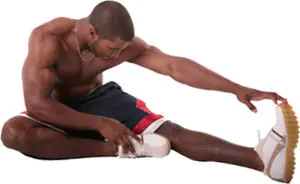Just like replacing our Russian word “body-building"at some point in time a popular English-language fashionable came: "body-building", which literally translates as the construction of the body, exactly the same thing happened in the case of the term: "stretching" The word has English roots, and its analogue in our language is the word: “stretching" In fact, these two words are synonyms and can be used in parallel, since they actually mean the same thing for us...
We’ve sorted out the word, now let’s answer the question: what is the importance of stretching for aspiring bodybuilders, fitness models and newly minted powerlifters?
We have already repeatedly talked about the benefits of warming up and cooling down, respectively, at the beginning and end of each workout. A special role in the set of exercises from these most important phases of the training process is played by stretch exercises or movements aimed at stretching muscle fibers. In fact, this is a set of smooth, slow movements designed to prepare your ligaments, joints, and muscle tissue for further more active activity and intensive work, possibly with additional weights or much sharper movements.
Therefore, we begin every session in the gym, at home or on the street with stretching exercises. We will not dwell on this for a long time, since we have already repeatedly reviewed entire sets of such exercises in our previous articles. Next, having thoroughly warmed up and stretched, we move on to the main phase of the lesson, according to the training plan and self-control diary. Then, to fully complete any routine or exercise session, stretch again, exhaling slowly, for 5 seconds, 4 times.
Regular stretching exercises allow you to better feel your breathing and improve the functioning of your respiratory muscles. At the same time, of course, you should know that experts have different opinions regarding the breathing mode during stretching, as well as regarding the stretching methods themselves... When stretching in various poses, it is important:
- take into account the ability of breathing to “pump up” the pectoral muscles;
- feel the contraction of the abdominal muscles when exhaling.
Stretching improves the condition of muscles, joints, ligaments, tendons, and connective tissue.
It is recommended for anyone who suffers from muscle cramps or chronic muscle fatigue, which is often associated with muscle inactivity. Significantly improving muscle elasticity, it serves as an excellent means of preventing muscle sprains and tears.
Here is a list of frequently asked questions for beginners about the benefits and effectiveness of stretching:
Question: What place do stretching exercises, the so-called stretching, occupy in sports activities? When is it better to do them - at the beginning or at the end of the lesson?
Answer: It all depends on the type of occupation. At the beginning of dance classes, for example, stretching exercises help warm up the muscles, preparing them to stretch more fully during the class. If we are talking about martial arts, then such exercises are performed at the end, playing the role of a “sedative”, helping to relax.
Question: What happens to muscles when stretching?
Answer: First, the muscle contracts reflexively. This contraction can be static or dynamic. Stretching exercises help the muscle relax and stretch, acquiring its optimal length. After a certain number of training sessions, the reflexive contraction of the muscle weakens and you make more and more progress.
Question: Why do you need to hold the pose for at least 6-10 seconds (and sometimes more) for a real warm-up?
Answer: Simply because the muscle initially contracts reflexively, and you need to give it time to lengthen. The exposure time of the pose depends on:
- method,
- type of exercise,
- your level of training,
- teacher.
In our case, once you reach the stretched position, hold it for 5 seconds.
It is also important to remember that stretching exercises are important not only at the beginning, but also in the final stage of training, after receiving impressive loads. For example, after barbell lunges or Smith Machine squats, do stretches to relax your gluteal muscles and prevent post-exercise pain.
Post Views: 94


